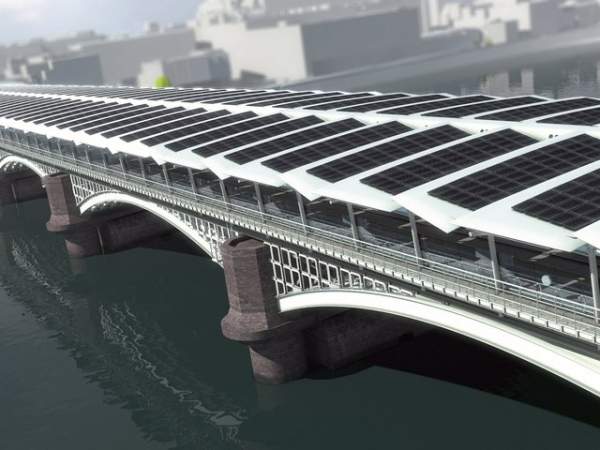The Blackfriars solar bridge, located across the River Thames in London, was opened in January 2014. The bridge was developed as part of a major upgrade of Blackfriars Railway Station.
The bridge is the largest and only the second of its kind in the world. The world’s first solar bridge is the Kurilpa Footbridge, which was built in 2009 in Brisbane, Australia.
Work on the Blackfriars project began in October 2011.. Some 4,400 solar photovoltaic (PV) panels were placed on the new roof of the bridge. It is the largest solar array in London.
Blackfriars Railway Station upgrade
Network Rail reconstructed the new Blackfriars station as part of the Thameslink Programme. The project included reconstruction of the Victorian era rail bridge, a new station over the River Thames and a new London Underground station.
The new Blackfriars station was built on the reconstructed rail bridge. The station has two entrances on the south and north banks of the river. They were opened in December 2011. The reconstructed rail bridge enables First Capital Connect to run longer (12-carriage) trains on the Thameslink route. The solar panels are placed on the roof of the rail bridge.
Blackfriars solar bridge details
The 4,400 solar PV panels, installed on the new structure, are expected to meet 50% of the energy requirements of the station. They are estimated to generate 900,000kWh a year (at the rate of 850kWh/kWp). The location of the bridge and its large roof space of 6,000m2 made it ideal for the placement of solar panels. The fact that the bridge is a fixed structure ensures the panels to generate renewable energy for a long period into the future.
Improving sustainability of the Blackfriars station
The bridge allows the Blackfriars station to reduce its carbon dioxide emissions by an estimated 513t a year (calculated on the basis of the UK standard emission of 0.545kg CO2 per kWh). The bridge features solar pipes that provide natural lighting to the station during the day. It also has rain water harvesting systems.
Key players in the Blackfriars solar bridge development
London-based Solar Century engineered the project and installed the solar panels on the bridge. The co-operative worked in coordination with the upgrade project coordinators Jacobs Engineering on the design.
The solar modules were supplied by Sanyo Electric. The Department for Transport’s safety and environment fund financed the solar panels.
Sanyo HIT solar modules
The bridge roof is installed with Sanyo HIT (Heterojunction with Intrinsic Thin layer) solar cells, which are formed of thin mono-crystalline silicon wafer and ultra-thin amorphous silicon layers. They do not have any moving parts so are noise free.
It is also claimed that the cells are 100% free of emissions. The modules are 1,580mm high, 798mm wide and 35mm deep and they weigh 15kg. Their dimensions enable them to occupy less space than the conventional crystalline silicon cells.
The new design reduces the loss of electricity between the unit’s fingers and tabs, of which there are three. Anti-reflecting glass improves the generation of electricity in the morning and evening, reducing the waste of sunlight by controlling the scattering of the light.
Solar power market in the UK
The UK solar market is among the top ten in the world. It has a total energy generation capacity of 759MW. The country aims to generate 15% of its total energy from renewable sources by 2020.
In 2010, the UK Government introduced feed-in-tariff (FiT) to encourage households and businesses to generate renewable energy. Under the scheme, the government said it would pay 43p for every kilowatt-hour of renewable energy generated through solar PV panels, micro CHP (combined heat and power) systems or wind turbines.
The nation experienced a 60% increase in solar electricity generation in 2010 (from 20GWh in 2009 to 33GWh in 2010). The country was also the fastest growing solar power market in the world during that year. In 2011, the UK Government slashed the FiT for solar PV systems by half, to 21p per kilowatt-hour, which was vehemently opposed by the solar power industry.







